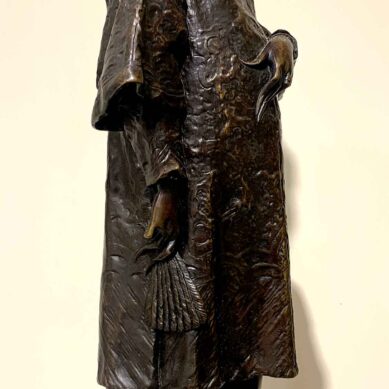You searched
Sculptor
Ugolino Panichi
Are you interested in the sales or the purchase of his artworks?
We buy works of this artist
and of other painters and sculptors from the 16th century to the first half of the 20th century
The Berardi gallery offers a free and without obligation service for evaluation of ancient and modern art . To find your way in the art market, very complex and full of nuances, it is better to rely on a professional consultant who can answer fast and concretely to your needs. The clarity of the answers will resolve effectively the need to estimate or sell an asset.
Contact us immediately without commitment
Answers also in 24 hours:
Ugolino Panichi
Ugolino Panichi
Ugolino Panichi was born in Ascoli Piceno in 1839. Having soon demonstrated his artistic talent, he moved to Florence when he was only twenty-two years old to cultivate his vocation as a sculptor. In the 1960s, the Tuscan city was still in the midst of artistic ferment due to the spread of macchia painting.
And it was the Macchiaioli artists who were the Florentine friends of the young Panichi, who became a regular visitor to the Caffè Michelangelo. But his formative period also allowed him to come into contact with the balanced and severe sculpture of the 15th century and the Renaissance, which he would rework in a personal key, through a special aptitude for conveying the introspection of the characters represented, but also the details of the costumes, the fabrics, the peculiar aspects of the faces and the hair styles.
The experience of studying in Florence was not the only one, in fact Ugolino Panichi, during the 1960s, assiduously frequented Paris, where he came into contact with the demands of European sculpture. At this point, his bronzes and plaster casts appear vibrant in the impressionist rendering of the surfaces, which nevertheless remain anchored in a refined and detailed realism.
Ugolino Panichi: realist sculpture, between psychological introspection and decorative details
His most important commission came in 1864, when he was commissioned to sculpt the monument to Giacomo Leopardi for the square in Recanati. The plaster model, with several variations, is in the Pinacoteca Civica in Ascoli Piceno, while the statue is still in situ. Appreciated also by Leopardi’s friend Antonio Ranieri, who closely followed its creation in Panichi’s studio, it combines the solemnity of the poet with his personal suffering, through the gesture of the folded arms and the austere but thoughtful face.
Ugolino Panichi’s most important works also include some Orientalist subjects: a Moor’s Head bought in 1916 from the National Gallery in Rome, but in storage at the Museo Civico in Ascoli Piceno, together with other works such as the Bust of Countess Lara.
Orientalist subjects
The extremely expressive Moor’s Head, with its slightly turned face and half-open mouth from which a sigh seems to escape, is a portrait of his servant.
From a simple bust of a servant, the work is transformed into a formidable Orientalist subject, in which the exotic features of the full lips and the hair made up of tiny, thick curls are combined with a frown that conveys an incredible vitality.
The same approach is used in the other exotic subject, one of Ugolino Panichi’s most popular works, the pair of Chinese Dignitaries in bronze, in which the attention to detail in the clothing and hair make these statuettes a jewel of Orientalist sculpture, in which the realism of the human rendering is combined with a brilliant decorativism.
Elena Lago







